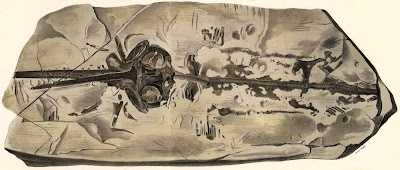Recently, I acquired a new book entitled The Fossil Woman A Life of Mary Anning by Tom Sharpe (published by The Dovecote Press, 2020). The subject of this book is perhaps one of the best known fossil hunters known for finding Jurassic age marine fossils in the 19th century. It is somewhat rare that I buy a modern book about fossils but I was intrigued enough to purchase this book from Blackwells of Oxford, England and have it shipped to the USA. An added incentive was the author is donating part of the proceeds to a campaign in Lyme Regis to create and display a statue of Mary Anning.
 |
| Lyme Regis England Coastline at high tide August 2016 |
 |
| The Cobb at Lyme Regis England in August 2016 |
The book is a creation of a lot of thorough research and contains modern images and events pertaining to Miss Anning. It clears up some of the myths and misinformation about this most famous paleontologist. As the author notes in his introduction, there is much information not known about Mary Anning due to a lot of her correspondence and journals are lost to time. Mr. Sharpe does a fine job with the material he does have to weave a story about her life. I would highly recommend this book if you are interested in learning more about Mary Anning, British paleontology in the 1800s, and the Jurassic coast of southern England.
 |
| Public domain image of William Buckland that is misidentified as Mary Anning on Wikipedia at https://commons.wikimedia.org/wiki/File:Mary_Anning.jpg |
One piece of misinformation I learned was an sketch of person walking along a landscape in a top hat and holding a rock hammer. It misidentified as being Mary and drawn by De la Beche. Mr. Sharpe marked as image 40 in his book as being a Thomas Sopwith sketch of William Buckland in Snowdonia (Wales) in 1841. The image is on Wikipedia's entry for Mary Anning (as of this writing) and it references the image on page 78 of a document entitled "Nomination of the Dorset and East Devon Coast for inclusion in the World Heritage List" by the Dorset County Council in the year 2000 [LINK]. I also wondered about this image how it was so different from the others of Mary. I assumed since she lived in poverty she would be very thin and the person in the image look almost overweight (so I assumed it was a lot of padding for the cold, windy environment of Dorset).
More things I learned that Mary Anning was a shrewd fossil dealer and an accomplished fossil preparer. Also that she was well known in the field with a number of newspaper and journal articles mentioning her while she was alive.
 |
| Dapedium politum fish fossil probably collected by Mary Anning displayed at the Lyme Regis Museum in Dorset England on August 2016. |
 | ||
| Ichthyosaurus communis fossil found by Mary Anning in 1820 and sold to Georges Cuvier. Displayed at the Muséum National d'Histoire Naturelle in Paris France August 2016. |
One sad item the books documents is so many of the Mary Anning fossils found were destroyed in World War II bombing of England and museum fires. The book lists the Bristol City Museum fossil collection destroyed in air raids on November 24-25, 1940 (in 1987 they a partial ichthyosaur skull fossil from Anning 1814 that survived the bombing) and on May 10, 1941 a night bombing of Royal College of Surgeons in London fossil reptile collection was mostly destroyed (396 of 400). In the United States, the New York Lyceum of Natural History had Anning specimens purchased in 1827 by G.W. Featherstonhaugh. This collection was destroyed in a fire on May 21, 1866. The author documents a number of other museums that have or had specimens but lost the labels so it difficult to know if Anning fossils still exist at those institutions.
When I was at the Natural History Museum of London in August 2016 and waiting in line for it open, I took some pictures of the Victoria and Albert Museum across the street which shows shrapnel damage made during World War II bombings of London.
Which just re-enforces the need for museums to digitize their collections. These vast store houses are not immune to loss. Which re-enforces that natural history collections need to be digitized and the data distributed across geographical distance servers so some record will exist if the original specimen is lost.
 |
| Image (Tab. 42) of watercolor of Squaoraja fish fossil found by Mary Anning December 1829. Louis Agassiz had image created for his book Poissons Fossiles, Atlas Tome III 1833-1845. He called it Spinacorhynus polyspondylus and image painted by J Charles Weber.The original fossil was destroyed in World War II at the Bristol City Museum however the tail section still exists in the Philpot collection at Oxford University Museum of Natural History. |
Again, I would encourage you to read this book if you are interested in the history of paleontology or if you plan on visiting Lyme Regis or the Natural Museum of History in London.






